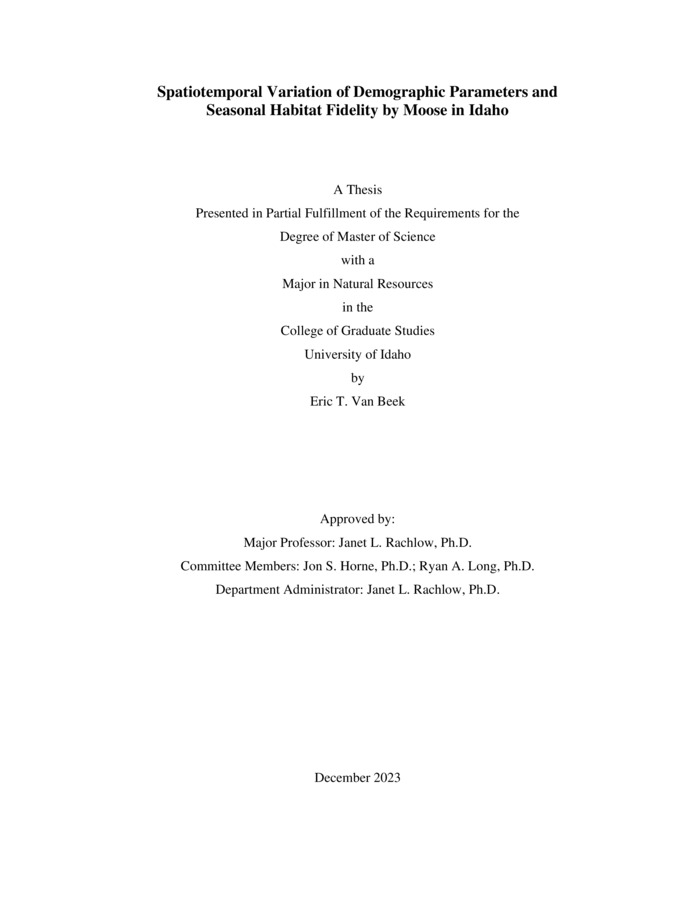Spatiotemporal Variation of Demographic Parameters and Seasonal Habitat Fidelity by Moose in Idaho.
Van Beek, Eric Thomas. (2023-12). Spatiotemporal Variation of Demographic Parameters and Seasonal Habitat Fidelity by Moose in Idaho.. Theses and Dissertations Collection, University of Idaho Library Digital Collections. https://www.lib.uidaho.edu/digital/etd/items/vanbeek_idaho_0089n_12667.html
- Title:
- Spatiotemporal Variation of Demographic Parameters and Seasonal Habitat Fidelity by Moose in Idaho.
- Author:
- Van Beek, Eric Thomas
- ORCID:
- 0009-0001-8987-9538
- Date:
- 2023-12
- Program:
- Natural Resources
- Subject Category:
- Wildlife management
- Abstract:
-
Hunter harvest and aerial survey data suggest that some moose populations in Idaho have been declining since the mid-1990s. However, longitudinal demographic data spanning the range of moose in Idaho are lacking, making it difficult to explain observed trends. We initiated a multi-year project in January 2020 to better understand population dynamics and habitat use by moose in Idaho. During January-March 2020 and 2021, we fitted 148 adult females and 17 9-month-old calves with GPS collars in 5 regions throughout Idaho, USA. We monitored collared moose to document survival and to facilitate investigation of mortalities. To document parturition rates and summer calf survival, we conducted ground observations of parturient collared females during May-August 2020-2022. We also used resource selection functions (RSF) to model and predict resource use by moose during a critical timeframe in the life cycle of an important parasite of moose, the winter tick (Dermacentor albipictus). Results from region specific RSFs were used to predict the relative probability of tick occurrence on the landscape which we interpreted as the “the tick risk landscape”. We then modeled the relationship between the tick risk landscape and relative tick burden on moose assessed at the time of capture. Our results indicated that moose populations were relatively stable during the study period. Furthermore, we found that spatiotemporal variation in population growth was almost completely correlated with spatiotemporal variation in adult female survival. This finding suggests that adult female survival is primarily responsible for observed population growth and should be a target for management action. We also found that as moose spent more time within the tick risk landscape, they acquired more ticks. The tick risk landscape can be used in future research to estimate tick load on moose and provide spatial boundaries for tick reduction efforts.
- Description:
- masters, M.S., Natural Resources -- University of Idaho - College of Graduate Studies, 2023-12
- Major Professor:
- Rachlow, Janet L
- Committee:
- Long, Ryan A; Horne, Jon S
- Defense Date:
- 2023-12
- Identifier:
- VanBeek_idaho_0089N_12667
- Type:
- Text
- Format Original:
- Format:
- application/pdf
- Rights:
- In Copyright - Educational Use Permitted. For more information, please contact University of Idaho Library Special Collections and Archives Department at libspec@uidaho.edu.
- Standardized Rights:
- http://rightsstatements.org/vocab/InC-EDU/1.0/

